The sports world has gone dark in recent weeks, filled with uncertainty over when we will see leagues around the world resume. We are also waiting to see the NWSL get back underway in the United States. While we could be on pause for a period of time, we still have plenty of talking points as we head towards the start of the new season.
The North Carolina Courage are going into this new campaign looking to defend their title. Much of the side remains the same from last season, but a couple of issues will need to be addressed. Additionally, while they won the title come seasons end, they did not go through the campaign without showing weaknesses that could be further exploited in the future.
In this tactical analysis scout report of the Courage, we will look at the major tactics in Paul Riley’s ride. This analysis will discuss their attacking and defending tactics, as well as look into the weak areas from this past season and how they might go about rectifying them moving forward.
Lineup
Riley will be happy that he will be able to rely on the majority of the same squad that he has been able to the past couple of seasons. The only major departure is Heather O’Reilly, who retired after last season to take up an assistant coaching position at the women’s football program of the University of North Carolina Chapel Hill.
They made four selections in the 2020 NWSL Draft. Their most notable addition is Ally Watt out of Texas A&M. The forward was selected with the sixth overall pick in the draft and will provide a lot of competition up top for Riley’s side moving into the seasons to come.
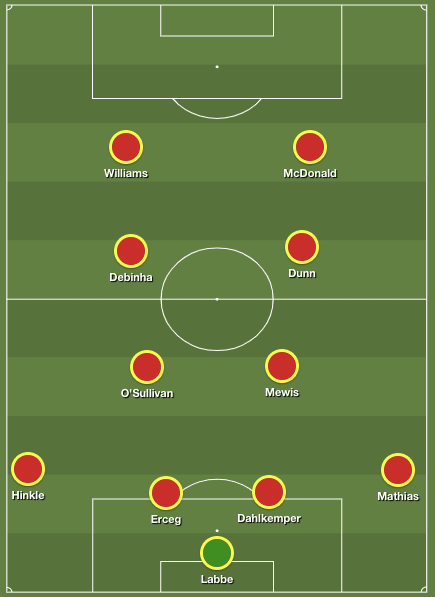
Above you can see the Courage’s usual formation, and the personnel we are likely to see begin the new campaign.
Midfield structure
The Courage have one of the most unique systems in the NWSL. They are well known for the box midfield they play in the 4-2-2-2 system. This structure is key to understanding what Riley’s side look to do in all areas of the match. Each player has specific responsibilities and roles that are key to this tactic working successfully.
As you can see in the section above, Denise O’Sullivan and Samantha Mewis form the double-pivot in front of the defensive line. Ahead of them, Debinha and Crystal Dunn are tasked with being the main attacking sparks in the side. They usually spend their time occupying the half-spaces. Here, they look to get into pockets of space in between the midfield and defensive lines to continue facilitating play forward from the back. Below you can see an image of this structure in a match.
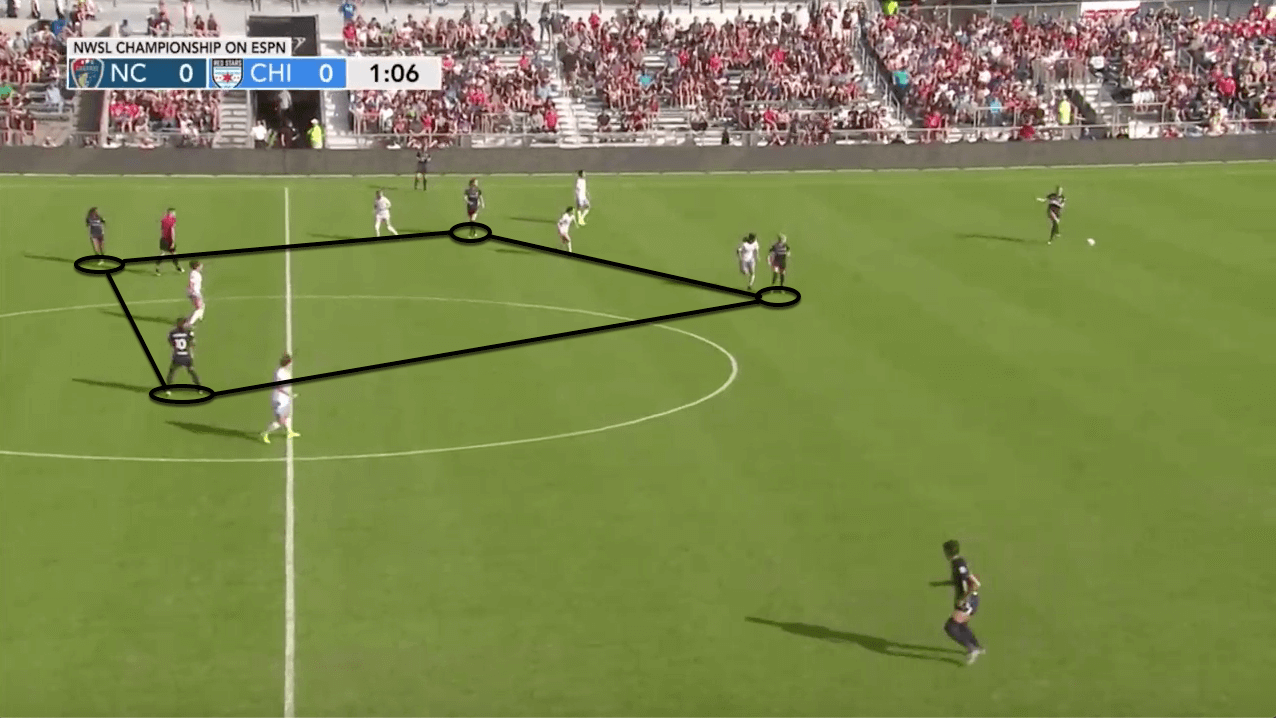
Mewis typically occupies the deepest position of the midfield four. She sets the tempo of the attack and looks for avenues to move through the opponent’s deep blocks. She also consistently transitions possession from side to side of the pitch as her side look to create openings. O’Sullivan stays close to the area of Mewis most of the time, but she is given the freedom to move forward when opportunities arise. She is very adept with the ball at her feet and can create space for her teammates by drawing out oppositions with her dribbling ability before finding an attacking teammate. She averaged 7.34 passes to the final third per 90 last season and completed 78.7% of these.
Ahead of them are the two main creators of the side as mentioned above. Debinha and Dunn look for little pockets of space in between the lines. When possession reaches this point, it is a difficult situation for defending teams. The midfield line has to react extremely quickly to try and get back into position and provide cover. If not, it leaves the defensive line with issues. If a defender steps forward, they will leave space in behind for one of the strikers to move into and look for a through ball. If they stay off, Dunn and Debinha are incredibly skilled dribblers who will take any chance they can get to have the ball at their feet. The two of them combined for 13.43 dribbles per 90 last season. Below, you can see an example of this. In the first image, Mewis has received possession and drives forward to draw out Portland’s initial press. Debinha acknowledges the space this opens up and makes a quick move into the centre of the pitch.
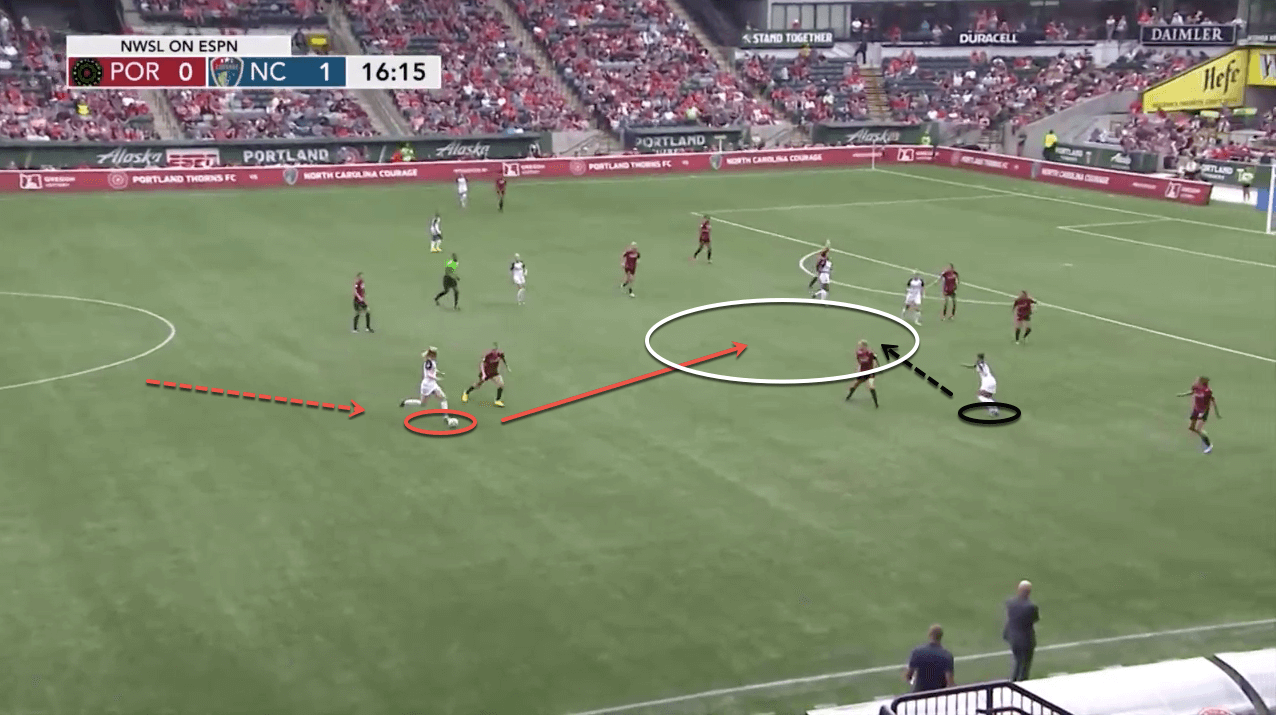
Her movement has beaten her marker and she is left completely isolated right in the heart of Portland’s defensive structure. With time and space, she is able to pick out a pass into the channel for a teammate to run onto. This example shows the danger these players represent in Riley’s system.
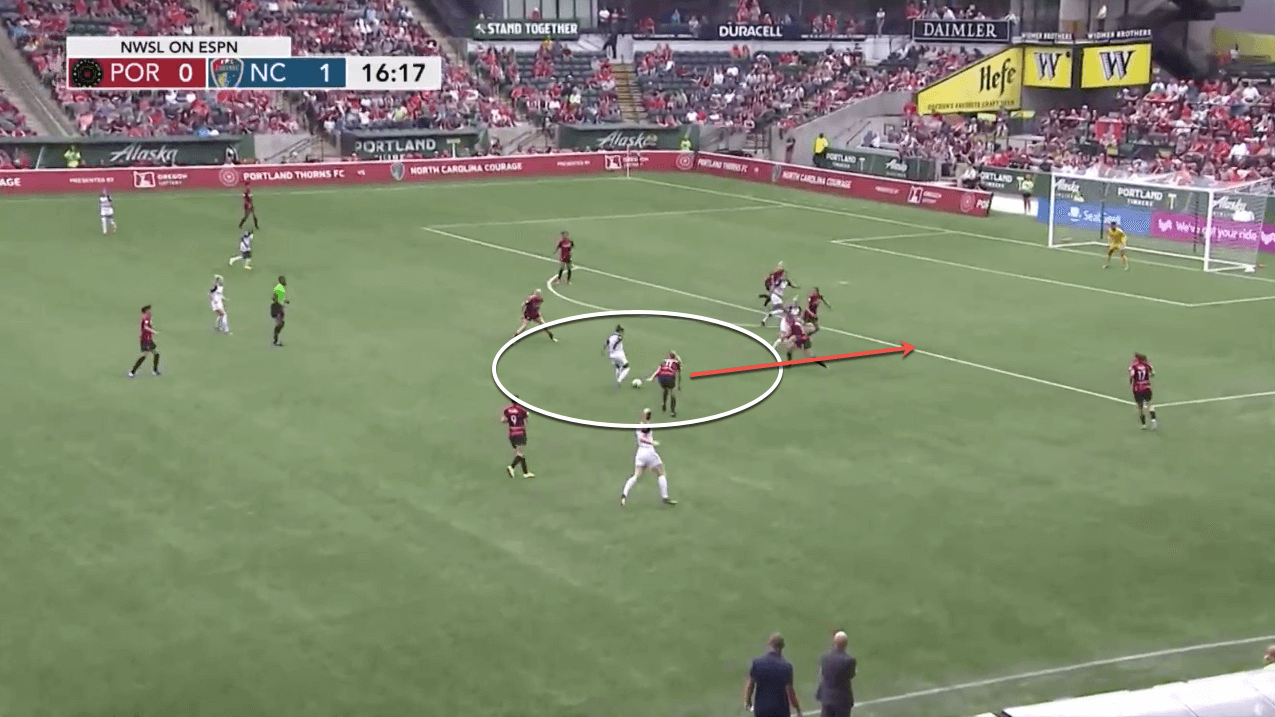
This midfield box is something we do not see on a regular basis. The narrow structure of this shape can make it difficult to defend them in these central areas due to the sheer number of players in this part of the pitch.
Attacking outlets
Ahead of the midfield, Lynn Williams and Jessica McDonald have formed a dynamic partnership in recent years and will be looking to continue this into the new year. Both are gifted with an abundance of pace to be able to make runs in behind the opponent’s defensive line as the Courage look to break down blocks.
Their favourite run to make is into the half-space behind the centre-halves. They often start in very central positions before making a move off of the shoulder of centre-half. With the passing ability of the midfielders in the Courage’s use, they are extremely successful with this tactic.
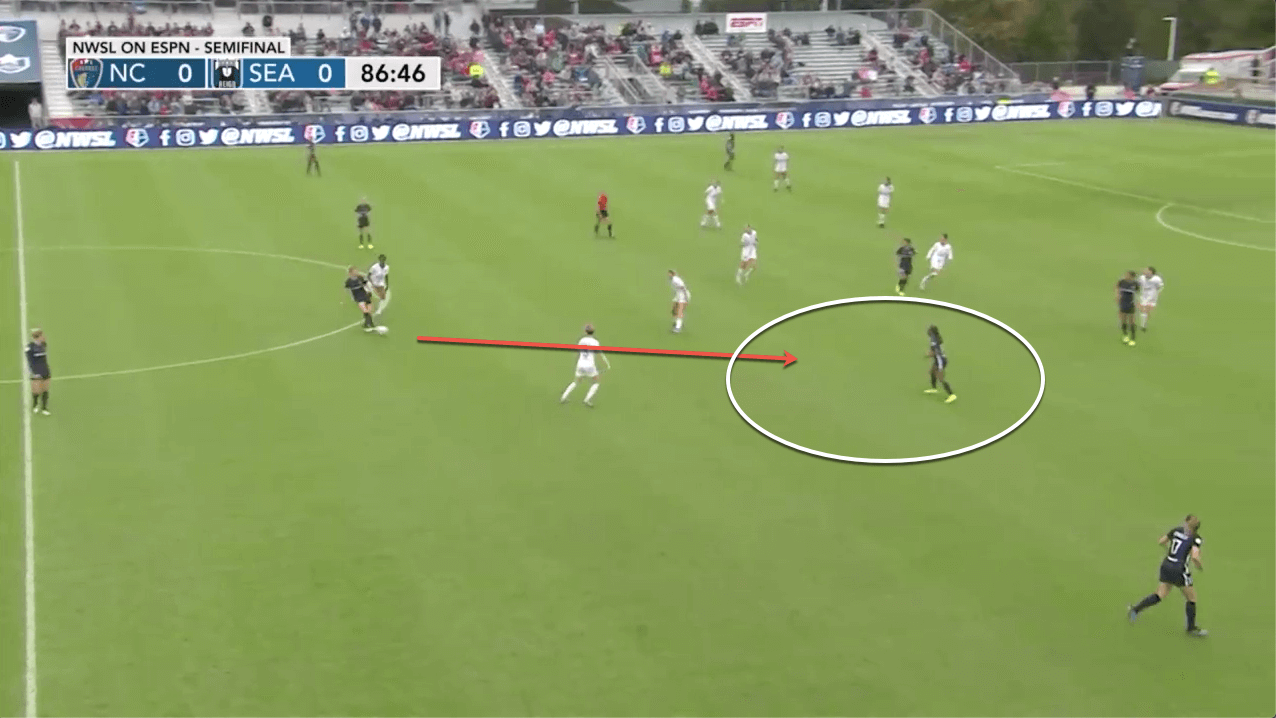
In the image above, we can see another example of the space the midfielders look to occupy. In this one, Dunn has found space away from the defensive set-up to receive a pass before turning to move forward.
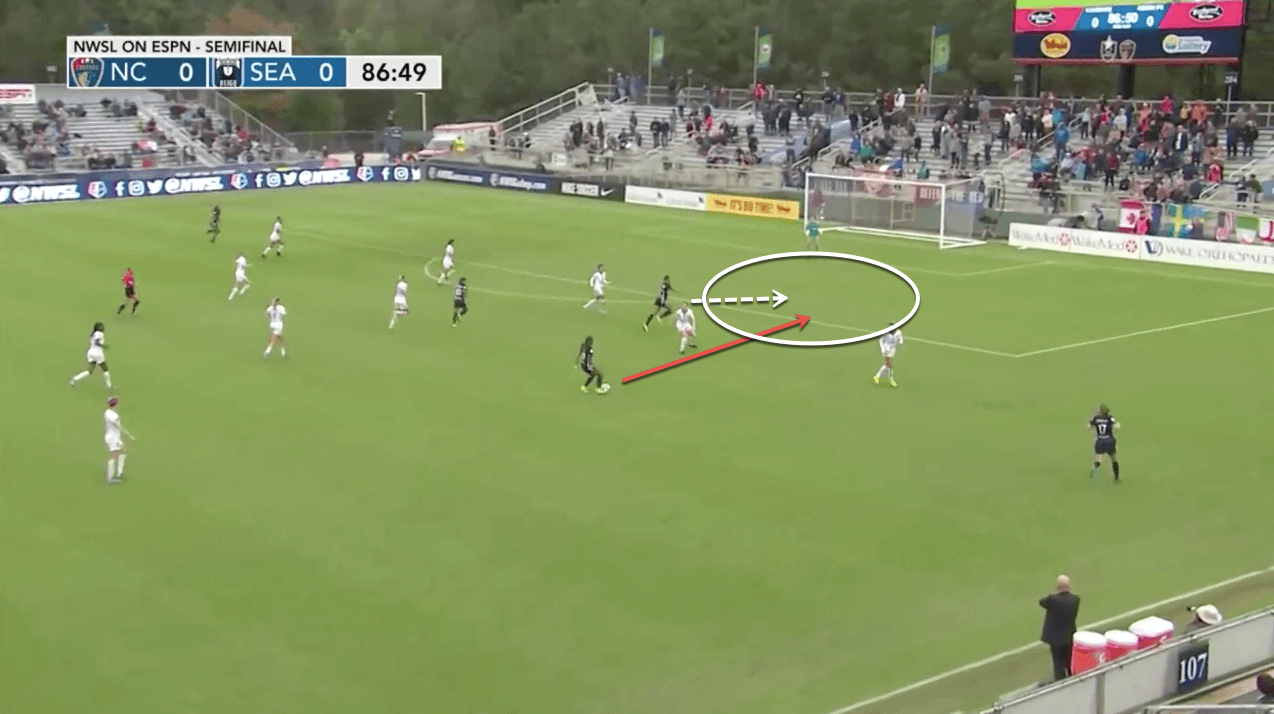
When she receives possession, the forwards ahead of her look to find space to run in behind. Williams starts from a central position and runs off of the shoulder of the Reign FC centre-half. Her run is perfectly timed and Dunn is able to find her behind the defensive line. The centre-half struggles to recover and in her attempt to do so gives away a penalty for a handball as Williams crosses it into her teammates arriving in the penalty area.
When the Courage have the opportunity to get forward on the break, the strikers play an interesting role. As one of the midfielders look to dribble forward to attack with numbers with their opponent having players forward, the role of the strikers is to create space. To do this, they will typically move out into the wide areas on the outside of the defenders. This opens up the centre of the pitch for Debinha or Dunn usually and does not allow the defence to collapse in on the player in possession. They also offer excellent passing options in these positions, as McDonald and Williams are both skilled at beating a defender in 1v1 scenarios. McDonald attempted 4.7 dribbles per 90 last campaign and completed an impressive 64.8% of them.
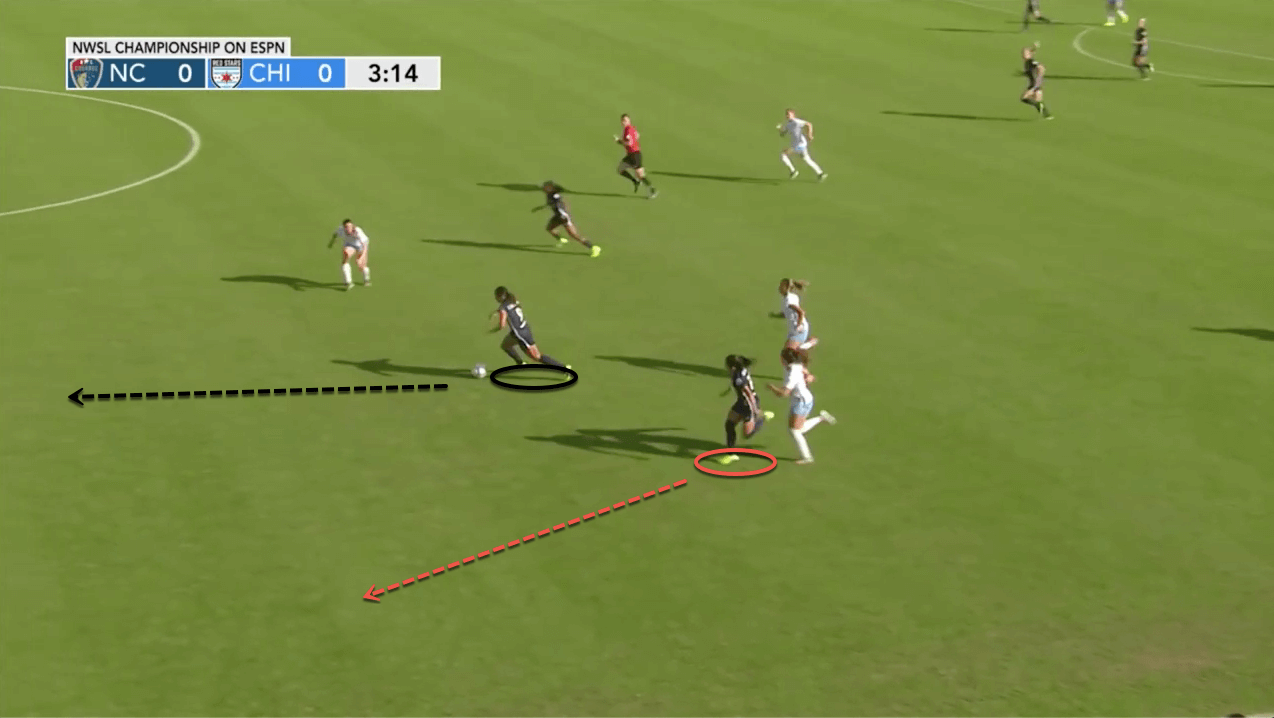
In the image above you can see Williams gaining possession in her own half. Chicago have numbers forward, and the attacker identifies the opportunity to break with speed and goes to drive up the pitch. As she makes her way into the centre of the pitch, Debinha runs on the outside of her to the left to provide width. On the right, McDonald uses this tactic we have discussed and moves almost to the right sideline to provide a passing option to her strike partner, as you can see below.
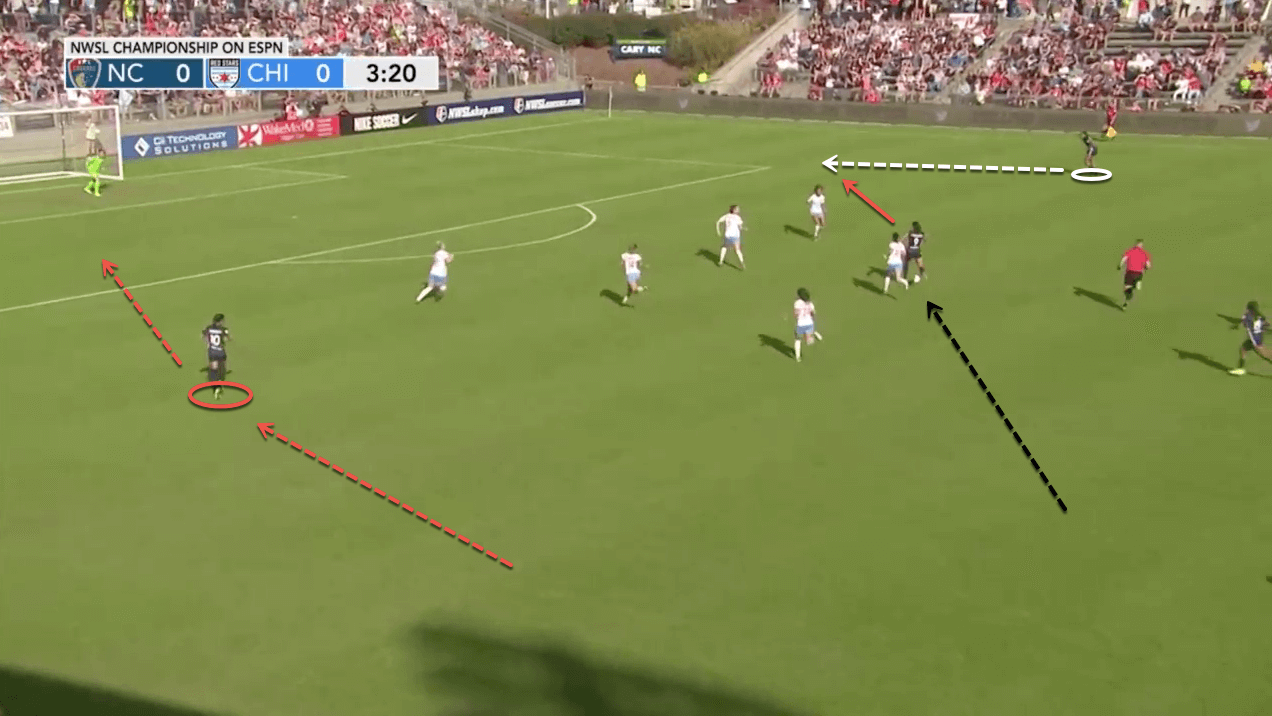
Williams plays in McDonald when the Chicago full-back commits too much onto the inside. McDonald receives the pass and makes a cross in front of the goal, and after some confusion in the box, Debinha puts it in the net to give the Courage the lead in this match.
Counter-pressing scheme
With the attacking intent Riley sets his side out to play with, an effective counter-pressing scheme is essential to their success. Every player in their side possess an abundance of attacking ability, but they must remain sound in their structure. In this analysis, we will look at how they go about this.
When in possession, the role Mewis provides is essential in North Carolina’s defensive solidity. While O’Sullivan looks for opportunities to get higher up the pitch, Mewis drops in deeper. At times she will even fall in line with the centre-halves. This gives the full-backs more freedom to move forward and provide width to the side, which is something we will discuss more in-depth a little later.
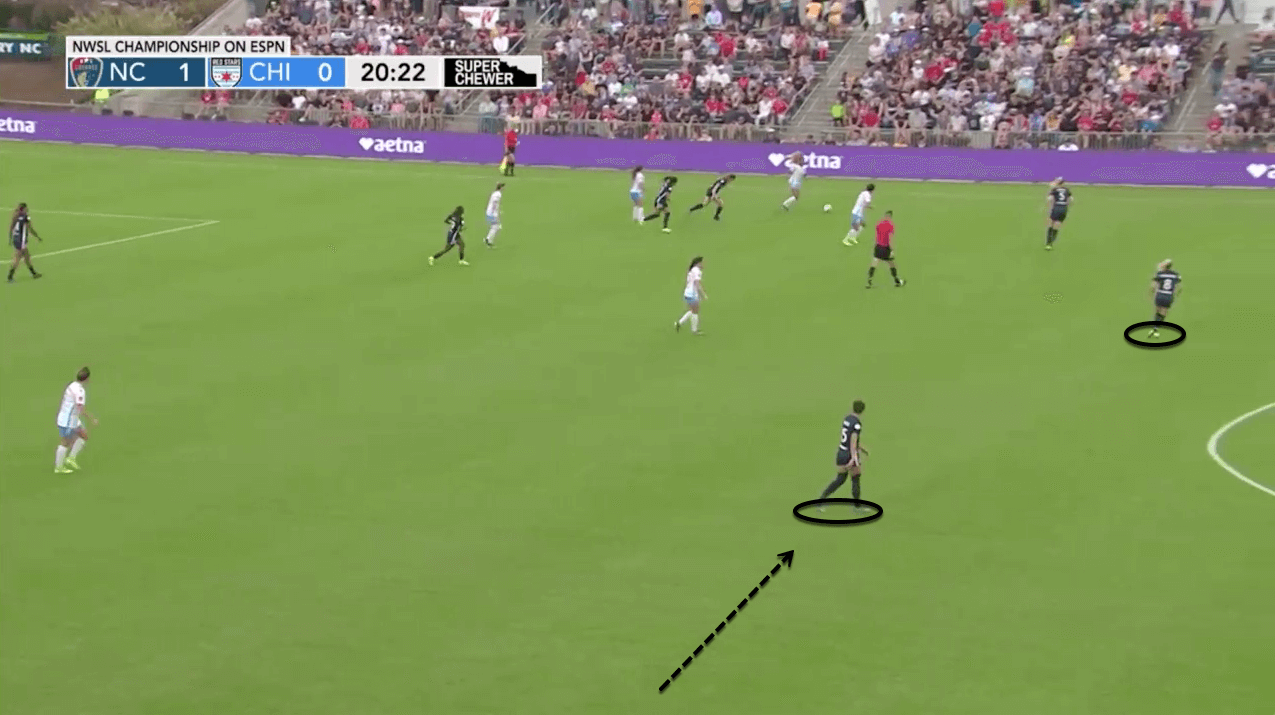
This will typically leave the Courage with four players occupying a defensive position while in possession, with one full-back staying back as the other gets forward most of the time. In the image you can see above, when the Courage have possession on the right side of the pitch, Jaelene Hinkle occupies a deeper position and moves more central to be able to provide defensive security when possession is lost. In this scenario, Chicago tried getting the ball up to Chelsea‘s Sam Kerr when they got the ball, but the Courage had four players back and easily outnumbered the striker, winning possession back with ease.
When possession is lost, the Courage look to regain it extremely quickly. Riley likes his side to have the control of possession in most matches, and they averaged 56.42% last season. This was possible in large part due to this aggressive pressing structure. Their passes per defensive action average was 7.45, showing how quickly they looked to make a defensive intervention when the opponent was in possession.
The Courage’s defensive set-up typically look to guide counter-attacks into wide areas. Due to Mewis’ role holding a deep space, Abby Erceg and Abby Dahlkemper are given the ability to move into wider areas to close down oppositions. They will look to stand them up and force the player to go backwards. Here, the full-back will be retreating into position and they will move to gain a numerical superiority in these areas. This often leads to the opposition making a poor pass or clearing the ball to allow her side time to regroup. This emphasis is also shown in the positional attack averages. The Courage averaged 41.35 positional attacks per 90 while limiting the opponents to an average of 21.58 over the course of the last campaign.
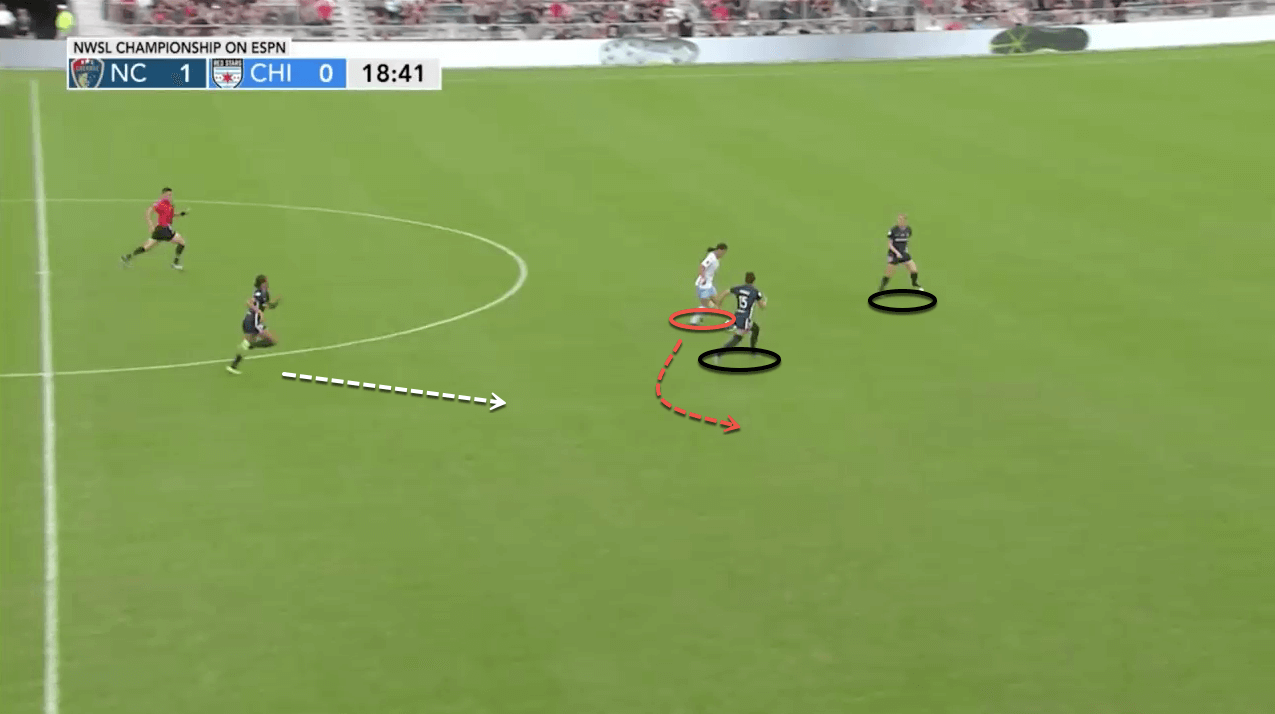
Above, you can see an example in a match between Courage and Chicago. In this image, possession has found its way quickly to Kerr who finds herself in a 1v1 against Dahlkemper for North Carolina. The centre-back remains composed, however, and is able to stand up the Australian attacker. Erceg is able to recover and forces Kerr wide.
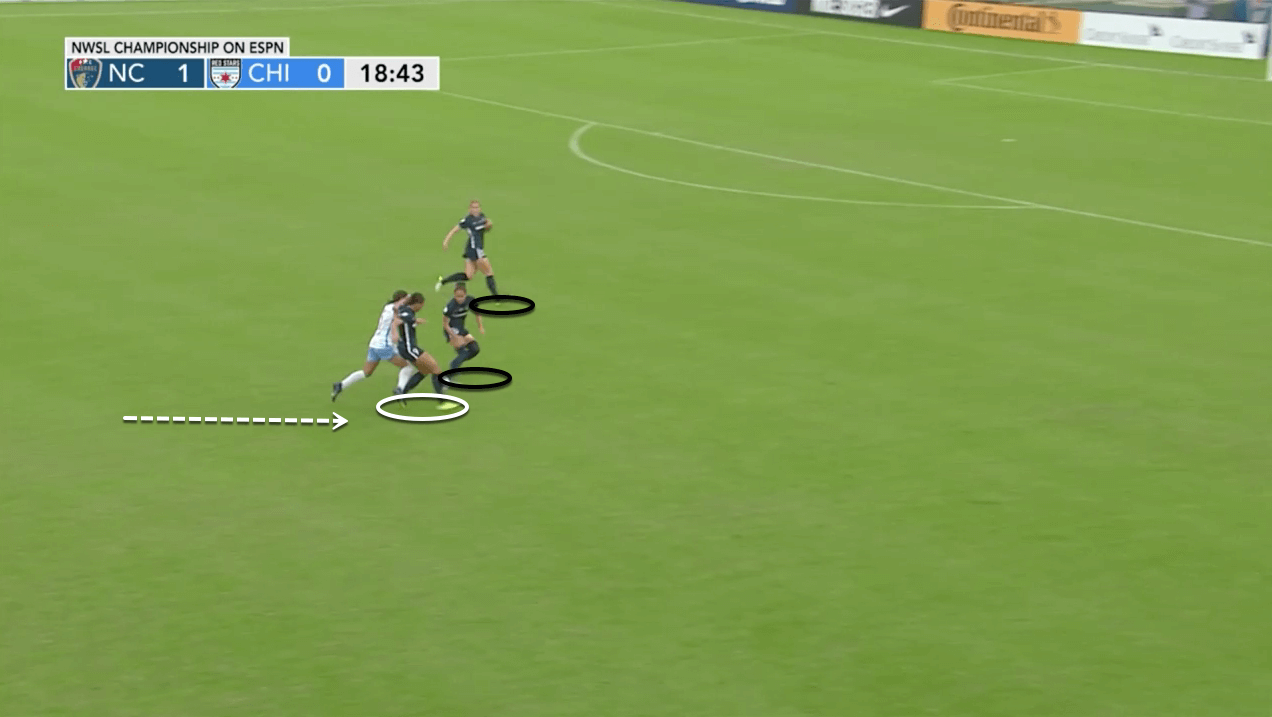
Without support and due to the quick press from the Courage, a third player gets back and regains possession from behind Kerr. This example represents just how committed the North Carolina players are to getting back to defend in numbers. When the ball is won, Riley’s side return to their attacking structure and look to begin their initial build-up once more.
Last season’s problems
In their match against the Washington Spirit, in which the Courage lost 2-1, they conceded twice on an expected Goals Allowed (xGA) of 0.51. When this happens, it is typically a result of the counter-pressing structure not being implemented effectively, or players moving out of position in situations where they should be staying in a defensive orientation in relation to their teammates who are getting forward.
This issue normally came against teams who effectively set up their defensive block. One negative side of the box midfield that the Courage utilise is the narrowness of it. Due to this, sides can often forgo leaving two or more players to look to cover wide areas and instead crowd the middle in front of the defensive line.
When sides did this effectively last season, the Courage were unable to progress play forward as they like to. Instead of passing into the feet of Debinha and Dunn, the defenders and holding midfielders oftentimes would look to go direct to the strikers. This normally came in the form of balls over the top into the channels. However, due to the deep nature of these blocks most of the time, there was not the needed space in behind for the strikers to get on the end of these passes, and they would go out of play or the defender would get back to make the interception.
When the Courage struggle breaking down sides, we will normally see the full-backs get more and more attacking as time goes on. While this offers width to the side that they might have lacked at times, it also makes them more vulnerable in the defensive transition when possession is lost. This is the key reason behind the low xGA numbers as we saw above in matches where the Courage lose. While they do not give up a big number of opportunities, if they are not effectively set-up in the defensive side of their game it can give the opponent an easier time when they do get their chances.
Potential solutions
A potential structural shift in the Courage’s tactics could go a long way in aiding both of these issues we saw last campaign. With the need for added width and cover, giving the advanced midfielders more of a role in providing width for the side could help the full-backs in their roles throughout the match. This could come in the form of an asymmetric formation. On one side, a full-back would push high up to provide the width. The centre-halves would then shift over to this side to offer support in the event of possession being lost. The other full-back would tuck in to create a back-three, or even invert alongside Mewis to provide central cover to the side. This would also give O’Sullivan even more freedom to move forward.
To keep width on this side, Dunn or Debinha could move into a wider area, floating in between the wide channel and half-space. The other could then move to occupy a central position. Below you can see an example of how this formation could potentially look, and the roles each player would have in moving to fit a specific need of the side.
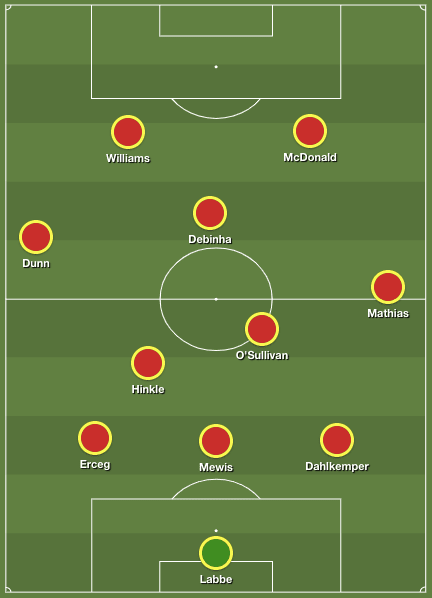
This shape could allow the Courage to utilise the entire pitch more effectively against deeper blocks than they have in the past. We have seen in some matches as the side became frustrated trying to break down opponents, both full-backs would begin to push further forward to provide this width. While this has worked at times, it also has the potential to hurt the Courage as they break away from their counter-pressing structure to do this. Using one of the attacking midfielders to provide width on one side would keep a full-back in a deeper position to keep the side solid. It would also open up more room for the likes of O’Sullivan to drive forward and look to combine with her side’s advanced attackers.
Conclusion
The North Carolina Courage had a fantastic campaign last year, but they do not have a lot of room to relax at the top of the league. Sides such as Chicago and Portland will be itching to come back this season and put up another big fight for the title.
The Courage debatably have the strongest side in the NWSL, and one of the strongest in women’s football in general. Their unique tactics along with the players they have in their side make them a very dangerous team. However, the issues they have shown in past seasons will need to be worked on to continue to move in the right direction this season and beyond. That being said, Riley has all the tools to be able to implement these changes and continue North Carolina’s dominance once more, and they will be considered favourites once again as we wait patiently on the new season to come.





Comments